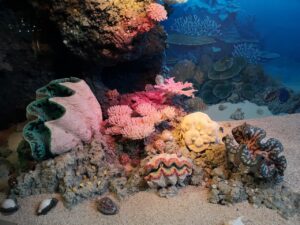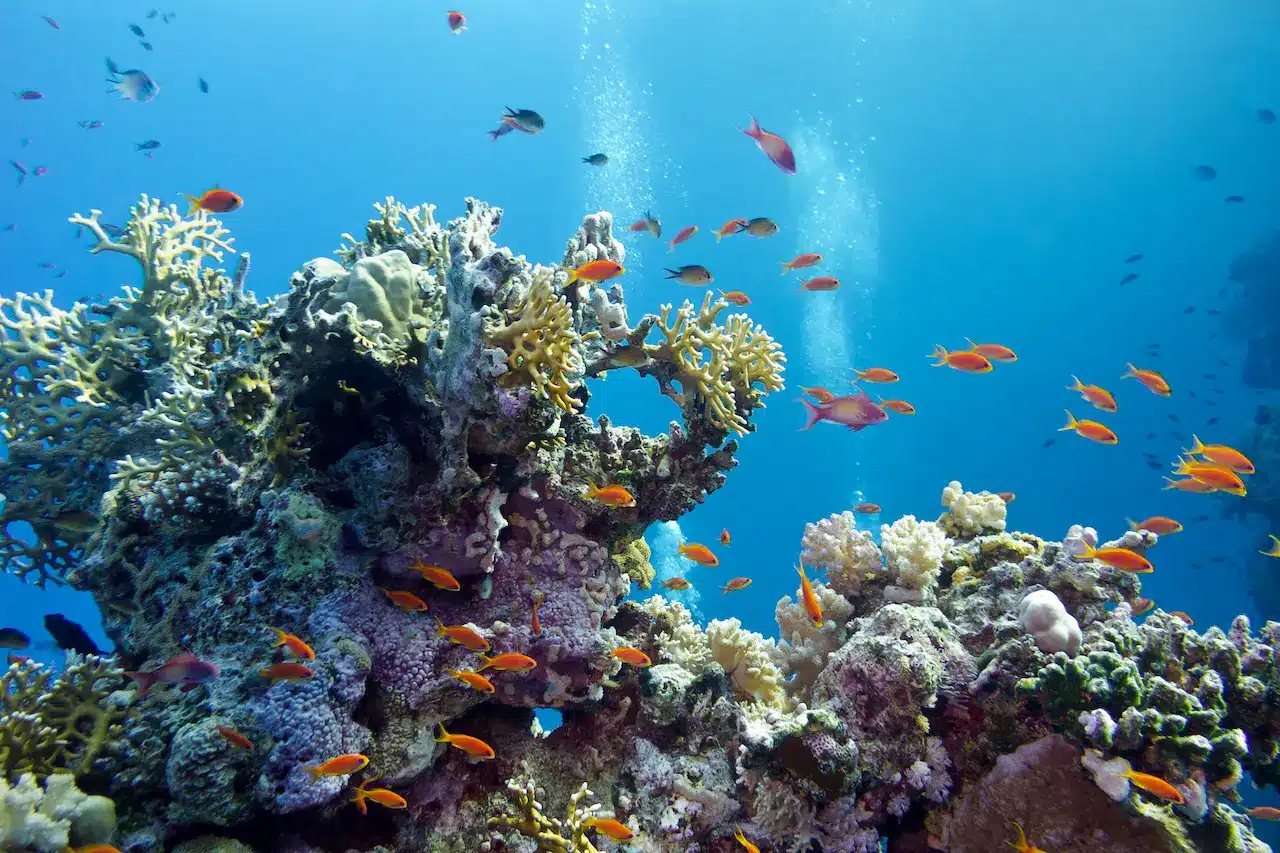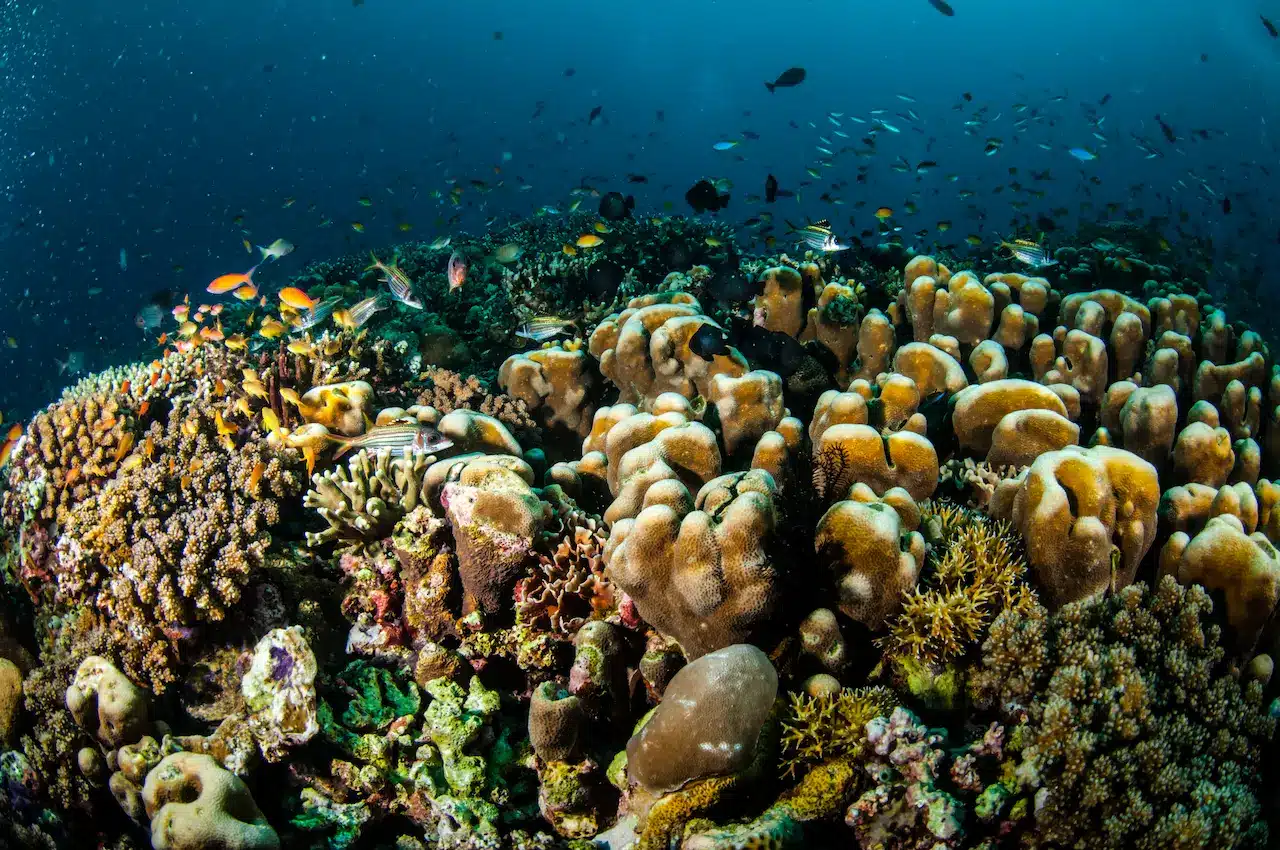Interesting Facts About Coral Reefs & Fish
Imagine the coral reefs of the ocean. They are a riot of colors and shapes. Coral is stunningly beautiful, but there’s more to it than meets the eyes. Discover what makes coral so special, and why it is important to protect for the oceans and planet.
Table of Contents
ToggleCorals Are Animals
Corals, with their branch-like features and hard calcium carbonate skeletons, are often mistakenly thought of as plants or rocks, but are actually animals!
Ross Cunning, Shedd Research biologist and Dr. Ross Cunning.
Coral reefs are built from small polyps that have a mouth and stomach. Slow-growing organisms like corals start out as just one polyp, and over thousands or hundreds of years can grow to colonies the size of a house or car!
Coral reefs can be seen in outer space and are among the largest living structures on earth.
Corals can be fluorescent
Cunning explained that some corals produce fluorescent pigments in a variety of colors. It’s believed that fluorescent molecules could have a protective role to shield coral against ultraviolet and high-light.
Corals are an indicator species. This means that they are sensitive to changes in the ecosystem. Coral colonies can live hundreds or even thousands of years in perfect environmental conditions. Researchers believe they could survive forever in perfect conditions.
Corals eat plankton/small fish
Coral polyps have stinging cells on their tentacles, which are used as harpoons for spearing plankton (floating plants and animals). Corals also have stinging cell like their jellyfish cousins to help them catch and debilitate their plankton or fish prey.
Coral cells have a mutually beneficial relationship with algae. The tiny algae that live in the coral cells harness sunlight and use it to produce food. Yum!
Corals Come in Hundreds of Colors, Forms and Shapes
Corals come in a wide variety of shapes, colors and sizes. The mound corals and boulders are huge, round mounds that grow on the seafloor. Brain corals resemble a human’s brain with their maze-like patterning.
Branching corals may grow in a tree-like manner or flatten out to create a top. Sea fans are a soft coral that does not have a hard exoskeleton. They have large flat fans that gently wave back and forth in the current. Sea whips or sea pens look like trees and can create an underwater forest. In colonies, pillar corals can grow as tall columns, which look like city skylines.
Corals Can Move
Corals can swim in their larval stage, even though they are usually attached to the ocean’s floor.
Corals release eggs and sperm into the water when they reproduce. The coral larvae are formed when the sperm and eggs fertilize. They can swim along ocean currents, and when they find an ideal place to live they attach themselves to the seabed and grow into new coral colonies.
Corals support 25 percent of ocean life
Corals are sometimes referred to by the terms architect or foundational species or ecosystem engineers for their role in constructing physical spaces that animals can live.
Cunning stated, “Think of coral reefs as an underwater forest. A three-dimensional structure that grows up from the ocean floor.” “There wouldn’t be a forest without trees.” The coral reef’s framework, its nooks, and crannies, provide a habitat for a large, diverse community of marine life.
Corals provide food and income to hundreds of millions of people. Coral reefs are responsible for our white sandy beaches, and they protect us from 90 percent of damaging waves and floods. Coral reefs are estimated to provide benefits worth $10 trillion a year.
Climate Change is the biggest threat to corals
The warming waters caused by climate change put a great deal of stress on coral populations.
Cunning explained that “Coral Bleaching is a stress reaction corals have when water temperatures are too high.” “Rising ocean temperature is causing corals ‘bleach,’ which means they expel their symbiotic alga. This leaves them bare-white and susceptible to disease and starvation. “Bleached corals will starve and die if water temperatures don’t drop.”
Climate change is causing coral bleaching to occur more often and with greater severity. Cunning warned that climate change could wipe out coral reefs in the next few years if we don’t reduce greenhouse gas emissions.
Everybody can do their part to help reduce the impact of the climate change. For example, state and national representatives should take immediate and dramatic actions in climate change policy. They also need to raise awareness about the importance of climate advocacy and communicate it.
We can save coral reefs, and other ecosystems in danger, if we take this step.
Coral reefs are a natural barrier to wildlife
Barrier reefs are named so because they shield shallow, warm water from the open ocean. This creates a habitat that is important for many tropical and rare fish.
There are three types of coral reef
Coral reefs are divided into three categories: atolls, barrier coral reefs and fringing coral reefs. Barrier reefs lie farther out at sea, while fringing coral reefs are located near the shore. Atolls are often mistaken for Islands due to their size and the fact that they appear around a lagoon’s rim.
Coral requires sunlight to grow
Corals need sunlight to grow. This is why they are found in shallow waters. coral reefs are unlikely to be found deeper than 45 feet. They also prefer tropical seas because the water is clearer and warmer.
The oldest reefs date back thousands of years
The Great Barrier Reef, Australia’s largest visible reef, is between 5,001 and 10,000 years. It has expanded to cover 2,600 miles and 500 islands.
Coral reefs stabilize the seabed
Coral reefs increase the structural integrity of seabeds. They do this by encouraging the growth of seagrasses, and other sea plants. More plant life on the seabed means it will be more stable. It reduces the effect of storms and tides on the shoreline.
They also cleanse the water
Coral reefs are also good for water quality. Plants, animals and organisms serve as filters, trapping dirt that helps to clean the environment. Coral reefs grow bigger in areas where the currents are stronger, as they provide more nutrients to the ecosystem.
Reefs provide important nesting areas
Coral reefs are important breeding habitats for marine animals like dugongs because of the calm and warm waters surrounding them. Coral reefs are also important nurseries for dugongs due to the abundance of seagrass.
Algae on coral reefs is an animal
Algae that covers coral’s surface is not a plant. It’s an organism. Algae are diverse, ranging from tiny creatures to those with colorful tendrils. Benthic Diatoms, a microscopically small variety of algae, contributes a large proportion to the dense biomass on a coral reef.
Coral reefs may help treat cancer
Scientists discovered that coral reef organisms could be used as a treatment for cancer and other diseases. By studying coral reefs, researchers have developed proteins that target cancer cells.
Interesting read: Can Rats Eat Popcorn?
Reefs can help manage global warming
Last but not least, coral reefs play a vital role in regulating the carbon dioxide levels on our planet. Coral reefs are vital for regulating the carbon dioxide level in the ocean because they are a living breathing giant. These ecosystems are therefore important in managing global warming.


